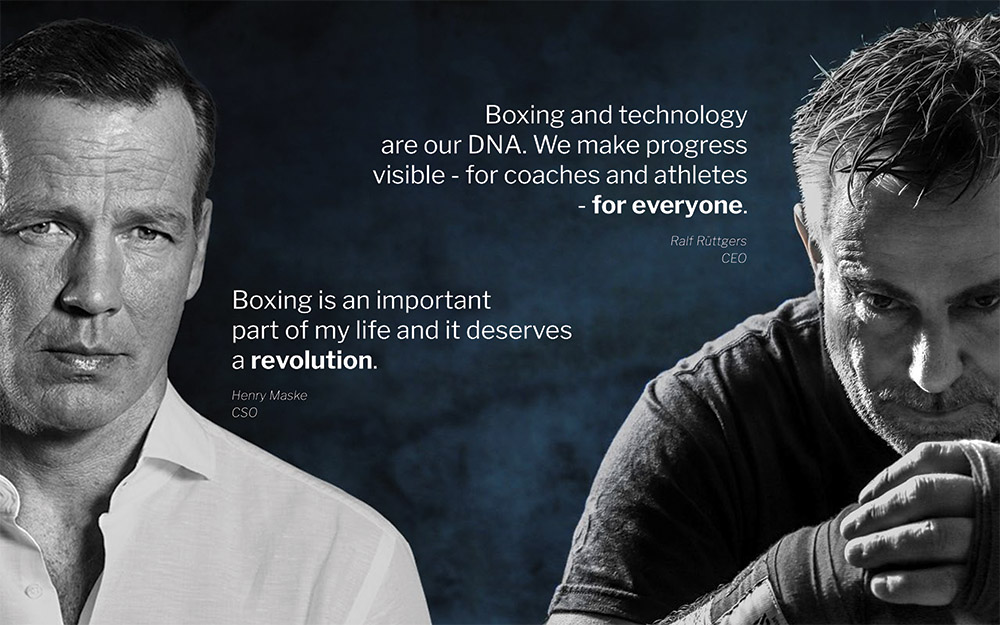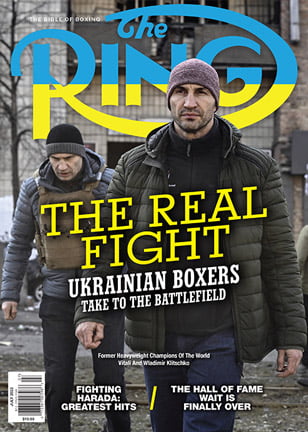
Own Your Fight With ROOQ
Advertorial
LEGENDARY FORMER LIGHT HEAVYWEIGHT CHAMPION HENRY MASKE ENDORSES ROOQ’S CUTTING-EDGE BOXING TECHNOLOGY
Two years ago, former light heavyweight champ Henry Maske contacted Ralf Rüttgers – a former amateur boxer-turned-mathematician and the founder of ROOQ – to set up his visit to the Aachen, Germany-based company to experience for himself the technology he had read about in an article.
Maske, a 1988 Olympic gold medalist and one of Germany’s most popular sports figures, put the ROOQ sensors through a two-hour training session of shadowboxing and heavy bag work while wearing different-sized gloves and changing his punch speeds and combinations.
 To Maske’s amazement, every punch – each jab, hook, cross, uppercut and body shot – that he threw during his session was recorded as well as the hand (left or right) and distance (close, mid-range, outside) it was delivered from. The speed and force of each punch was also recorded, along with the specific combinations and the total punch count. The tiny ROOQ sensors, which fit inside comfortable wristbands, recognized when Maske skipped rope, shadowboxed and when he hit the focus mitts or the heavy bag.
To Maske’s amazement, every punch – each jab, hook, cross, uppercut and body shot – that he threw during his session was recorded as well as the hand (left or right) and distance (close, mid-range, outside) it was delivered from. The speed and force of each punch was also recorded, along with the specific combinations and the total punch count. The tiny ROOQ sensors, which fit inside comfortable wristbands, recognized when Maske skipped rope, shadowboxed and when he hit the focus mitts or the heavy bag.
Maske was so impressed with the accuracy of ROOQ’s movement-measurement technology that he became a partner in the company as its Chief Sports Officer. As a product of the advanced sports science systems that made East Germany an Olympic powerhouse in every sport during the 1970s and ’80s, Maske appreciated the instant performance analysis that ROOQ provided and he viewed it as a potentially revolutionary tool in boxing training.
“Even in the ’70s and ’80s, East Germany had sports-evaluation technology and training methods that are still not used today, such as using a photoelectric camera to measure speed,” Maske said. “But everything had to be done in a laboratory setting. The process was time-consuming, and results came much later – days or even weeks later.
“ROOQ gives you all of that data in your hands, and in real time. My former boxing trainer would have loved to have this technology. I’m sure he would have loved to have come up with such technology, but he didn’t have the mathematical mind for the sport like Ralf does. Ralf boxed, he trained in boxing, and he cares about the sport. The sport is lucky to have someone like him, because this technology will finally advance boxing training into the digital world.”

Maske won the IBF light heavyweight title from respected veteran Prince Charles Williams in 1993 and made 10 defenses over the next three years, including victories over three-division titleholder Iran Barkley and former 168-pound beltholder Graciano Rocchigiani (twice).
His fights filled major arenas throughout Germany and averaged 17-20 million households on the RTL network. By all accounts, Maske’s amateur and professional careers were near perfect, and he admits that he strived for perfection in his preparation.
“I knew I didn’t have much athletic talent,” he said. “My talent was in my head. I wanted to win and I was very critical of myself. I was always thinking about how I could improve and how I would win. I always analyzed myself.”
Maske would have embraced ROOQ during his boxing competition years.

“I would have embraced this technology because it gives the boxer unbelievable clarity,” Maske said. “A boxer is not really sure of his capability or limits. It is the coach’s job to help the boxer realize his potential, to strengthen the boxer’s weaknesses and shortcomings.
“But sometimes the coach misses things, or sometimes the athlete doesn’t see what the coach sees. The great fighters can overcome this due to talent, but there are a lot of good boxers who fall short because they are not on the same page with their trainers. ROOQ gives the coach and the trainer the facts; they both see the same information.”
 One of ROOQ’s functions is the Coaching Zone, an online portal specifically geared towards the needs of the boxing trainer. All of the training statistics generated by the boxer is recorded via an app and cloud database, and the data can be made available to their coaches (given their approval).
One of ROOQ’s functions is the Coaching Zone, an online portal specifically geared towards the needs of the boxing trainer. All of the training statistics generated by the boxer is recorded via an app and cloud database, and the data can be made available to their coaches (given their approval).
“This is comparable to runners who naturally record their runs with an app or smartwatch,” said Maske. “For the boxing coach, this results in a concrete performance analysis.
“As an athlete, I knew my body was my tool, but it had to be fit. And my coach made sure of that. With the Coaching Zone function, we have the same information. We share it with the coach, who can make adjustments.”
“We are certain that the ROOQ sensors will soon be used as a natural training tool, as essential as the boxing gloves themselves,” added Rüttgers, who is also CEO of the company.
Maske was satisfied with the results of his technical boxing style but he believes he would have been a better athlete – and maybe a little more exciting – if he and his coach had ROOQ technology to train with during his boxing years.
“I think it would have encouraged me to put a little more power into my punches,” he said. “I may have scored a few more knockouts, although RTL may not have liked that (laughs). They liked it when I went all 12 rounds, more air time for commercials.”
Maske believes the ultimate potential of ROOQ goes far beyond boxing and even sports.
“Being a former boxer, Ralf started with boxing, but the technology is movement based, so it can be applied to other sports. I believe major MMA and boxing promotional companies will soon become partners with ROOQ, but I see the entire fitness industry eventually adopting the ROOQ system. It has huge potential.”
For more information on ROOQ’s cutting-edge technology and its many training applications, and to order a ROOQ BOX, please visit the official website.


